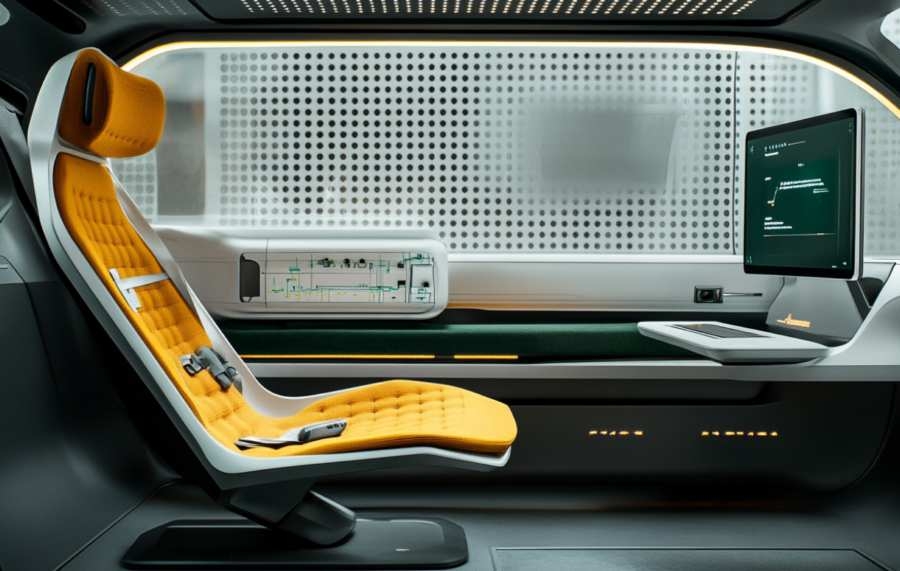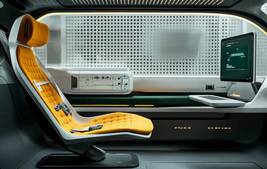Road-Minded Designs that Turn Passengers into Powerhouses
 A spark of productivity often arrives at the most inconvenient moment—usually while wedged into the back seat of a vehicle that seems engineered to discourage progress. Yet a well-designed chauffeur vehicle can transform that fleeting idea into a finished proposal before the next airport terminal glides into view. With clever ergonomics, subtle privacy enhancements, and displays that don’t trigger a full orchestral performance in one’s stomach, the right layout can convert downtime into serious deep-work time.
A spark of productivity often arrives at the most inconvenient moment—usually while wedged into the back seat of a vehicle that seems engineered to discourage progress. Yet a well-designed chauffeur vehicle can transform that fleeting idea into a finished proposal before the next airport terminal glides into view. With clever ergonomics, subtle privacy enhancements, and displays that don’t trigger a full orchestral performance in one’s stomach, the right layout can convert downtime into serious deep-work time.
Seat Ergonomics That Keep You Upright in More Ways Than One
Some seats cradle you like a friendly boulder, and others feel like they’ve been borrowed from a medieval museum. For productive travel, you want neither. Instead, the sweet spot lies in adjustable lumbar support, moderate firmness, and just enough contouring to discourage slouching without making you feel like you’re being gently vacuum-sealed into your trousers.
An ergonomic seat should allow small posture shifts, because staying in one rigid position is an excellent way to ensure your best work is a complaint email to the fleet manager. Business travelers often appreciate slight recline controls that don’t launch them into an unprofessional reclined pose reminiscent of a bored housecat. Subtlety is key.
Many premium chauffeur vehicles now include memory-foam blends that adapt to micro-movement. These do a surprisingly good job of maintaining comfort while taking the edge off long journeys. No need to emerge from the vehicle looking like you’ve just concluded a wrestling match with the upholstery.
Anti-Motion-Nausea Display Positioning (The Unsung Hero)
No matter how motivated someone is to hammer out a presentation, if their screen is bobbing around like a buoy in unforgiving seas, the only thing they’ll produce is regret. Proper display positioning is essential for deep work on the move.
Researchers have repeatedly shown that stable focal points minimize nausea. Translating this into chauffeur-friendly design means affixing displays to the most motion-neutral zones of the cabin—usually the seat-back ahead or a rigid arm integrated into the center console. The goal is to keep the screen as still as a stoic bodyguard.
Many modern luxury vehicles offer articulating mounts that glide into place with enviable smoothness. Travelers can adjust height and angle so the display sits within their natural sightline, eliminating the head-tilt posture that suggests someone is trying to decode ancient runes rather than answer emails.
If a mount isn’t available, a knee-resting laptop tray with non-slip material can stabilize screens surprisingly well. It’s not glamorous, but neither is motion sickness, so practicality wins by default.
Privacy Glass for Peaceful Productivity
Work requires focus, and focus often requires the comforting knowledge that no one outside is judging your concentration face. Privacy glass offers a barrier between a traveler and the outside world—both visually and psychologically.
Tinted glass has long been a standard, but newer electro-chromatic options allow passengers to shift from transparent to opaque in seconds. This gives travelers a moment of visual solitude, ideal for sensitive documents or brainstorming sessions that involve expressions too bizarre to be witnessed by pedestrians.
Some riders even report a subtle mental shift once the glass darkens—almost like entering a temporary office bubble. It’s remarkable what a touch of seclusion can do for productivity, especially when your workstation is technically hurtling down a highway.
Silent Communication Tools That Won’t Interrupt Flow
Deep work despises interruptions, and yet communication with the chauffeur must happen. Enter silent tools: small features that allow a passenger to relay requests without engaging in awkward mid-zoom-call shouting.
- Soft-glow request buttons that trigger dashboard notifications.
- Seat-side touch panels that send discrete prompts like temperature adjustments or route preferences.
- Short-range text systems integrated into the vehicle’s infotainment network.
These tools keep conversations efficient and noise levels low, freeing travelers to work without feeling like they’re moderating a very polite intercom system.
Cabin Layouts That Think Like an Office (But Smell Less Like One)
A mobile workspace should support the natural rhythm of thought, not pummel it with clutter. Smart cabin layouts accomplish this with surfaces, lighting, and accessibility that echo an office but avoid its usual aroma of stale coffee and quiet despair.
Some of the best configurations include slim fold-out desks with enough stability to accommodate a laptop, notepad, and the occasional emergency snack. These surfaces should deploy smoothly, without the alarming snap that suggests you’ve just activated a trapdoor. Lighting also matters—soft, directional LEDs that illuminate your work area without transforming the cabin into an interrogation scene.
Storage, although mundane, is surprisingly important. A shallow compartment for pens, tablets, or noise-canceling earbuds can save valuable time. It’s amazing how much productivity evaporates when you spend three minutes searching for a stylus that has mysteriously migrated to the far end of the seat.
Noise Management and the Sound of Silence
A productive workspace is a quiet workspace. While chauffeurs usually excel at smooth driving and polite conversation, a refined acoustic environment helps travelers sink into deeper focus.
Some vehicles now incorporate layered insulation, dual-pane glass, and vibration-canceling materials that work together like a hush button for the cabin. Others use active noise-cancelation systems embedded in the headliner—technologies that smother ambient roar so effectively that the loudest sound becomes the traveler’s typing or the contemplative sigh following an unexpectedly brilliant idea.
Fleet designers who prioritize acoustic serenity often report that passengers produce higher-quality work and show fewer signs of travel fatigue. It turns out that silence isn’t just golden—it’s billable.
Power Management: Because Dead Laptops Tell No Tales
Nothing derails deep work faster than a battery warning blinking like a tiny, taunting lighthouse. Well-designed chauffeur vehicles provide multiple charging points, ideally in both visible and tucked-away places.
USB-C ports, wireless charging pads, and even small inverters for high-demand devices can ensure that a traveler’s tools remain fully operational. Placement matters too—ports should be accessible without forcing passengers into an interpretive stretch routine.
Fast-charging options are especially helpful during short hops between meetings. In these scenarios, every watt feels like encouragement.
Environmental Controls That Don’t Require a Meteorology Degree
Climate control systems can make or break productivity. A cabin that’s too warm will lull travelers into drowsiness, while an overly enthusiastic AC can leave them typing with the posture of a startled penguin.
Simple, intuitive controls positioned within easy reach allow passengers to create a microclimate that keeps them comfortable and alert. Some vehicles even use zoned systems that fine-tune airflow around seating areas, preventing sudden gusts that scatter notes or transform hair into modern art.
Lighting temperature also plays a role. Slightly cooler light keeps the mind alert, while warmer tones assist in winding down once the work is done. The ideal system lets passengers slide between these modes without hunting through twelve menus of obscure icons.
Rolling Deadlines (A Pun Because You Asked for One)
Travel can either chip away at a workday or supercharge it. With thoughtful cabin layouts—ergonomic seating, steady displays, privacy on demand, quiet communication tools, and environmental controls that behave themselves—downtime becomes fertile creative territory.
When vehicles are designed to support serious focus, travelers often step out not only on schedule but ahead of it. The ride becomes more than a transition; it evolves into a stretch of time where ideas take form, tasks get completed, and the to-do list finally loosens its grip.
Productive travel isn’t magic. It’s simply the result of design choices that respect both comfort and concentration. And if along the way the cabin helps someone craft a pitch, finish a proposal, or at least avoid the universal dread of motion sickness, that’s a journey worth repeating.
|
|







 A spark of productivity often arrives at the most inconvenient moment—usually while wedged into the back seat of a vehicle that seems engineered to discourage progress. Yet a well-designed chauffeur vehicle can transform that fleeting idea into a finished proposal before the next airport terminal glides into view. With clever ergonomics, subtle privacy enhancements, and displays that don’t trigger a full orchestral performance in one’s stomach, the right layout can convert downtime into serious deep-work time.
A spark of productivity often arrives at the most inconvenient moment—usually while wedged into the back seat of a vehicle that seems engineered to discourage progress. Yet a well-designed chauffeur vehicle can transform that fleeting idea into a finished proposal before the next airport terminal glides into view. With clever ergonomics, subtle privacy enhancements, and displays that don’t trigger a full orchestral performance in one’s stomach, the right layout can convert downtime into serious deep-work time.